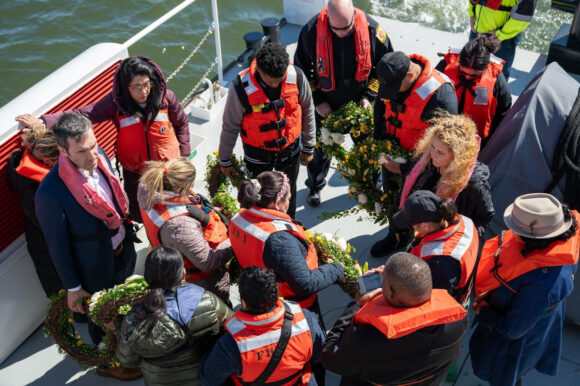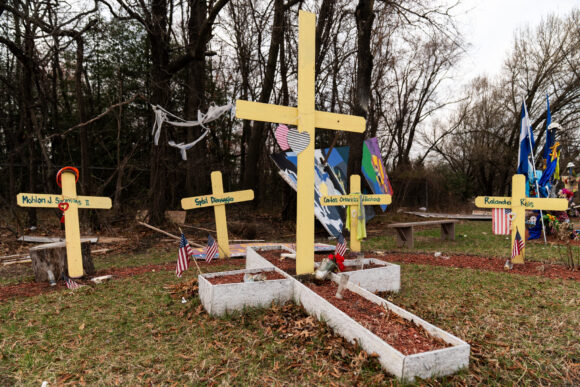
BALTIMORE – When Bobby LaPin was a young boy, his grandfather took him on his rickety boat to fish for bass and trout in the Patapsco River. Their route took them under the Francis Scott Key Bridge, where LaPin listened to the rumble of vehicles above and the crash of waves against its massive support columns.
For LaPin, the bridge symbolized cherished afternoons spent with his grandfather. Perhaps for that reason, he has struggled to get used to a Baltimore skyline without the steel truss bridge.
“It’s eerie not to see it out there anymore,” LaPin, 46, said. “When you grow up with something and it’s gone, it’s devastating.”
When a container vessel the size of a Manhattan skyscraper rammed into the Key Bridge one year ago, it was far more than a symbolic loss for the city. The maritime disaster killed six construction workers, temporarily shuttered one of the nation’s busiest ports, and spotlighted the vulnerabilities of aged bridges faced with increasingly larger cargo ships.
Now, a year later, the reality of the disaster still weighs on Baltimore and its residents, especially those in the working-class neighborhoods near where the four-lane bridge once stood.
Daily traffic delays plague east-west interstates, frustrating commuters. And businesses in neighborhoods isolated by the loss of the bridge are grappling with a sustained decline in revenue.
Still, many marvel at the pace of the recovery effort. The port of Baltimore rebounded after a seven-week closure and reported one of its most financially successful years. Meanwhile, authorities are preparing controlled demolitions to get rid of the remaining sections of the original bridge before starting construction on the new one.
“This time last year, I don’t think anyone thought things would be where they are today,” LaPin said.
The collapse of the Francis Scott Key Bridge
After midnight on March 26, 2024, the Dali, a 984-foot-long cargo ship, lost power while departing Baltimore’s harbor. The electrical breakers that fed most of the vessel’s equipment had tripped, according to the National Transportation Safety Board.
An emergency generator came online and the senior pilot steering the ship ordered the anchor dropped. But less than a quarter mile from the bridge, the ship lost power again. Police quickly closed both sides of the bridge – a decision credited with saving lives.
Less than three minutes later, the Singapore-flagged ship smashed into one of the bridge’s piers.
While the NTSB has yet to release its final report on the incident, the agency has faulted the state of Maryland for failing to conduct a risk assessment on the Key Bridge. The NTSB, which says the assessment would have shown the bridge’s vulnerabilities to such a strike, has since called for reviewing dozens of bridges across the country to reduce the chances of another major collapse
John Flansburg, who could once see the Key Bridge from his front yard in Dundalk, Maryland, recalls being shaken from his sleep by the crash.
“The house shook,” Flansburg, 66, said. Outside, he could see police lights flashing on both sides of the river, but the bridge was gone.
At dawn, he saw the devastation: 50,000 tons of twisted steel and concrete lay across the river and atop the deck of the ship. A streetlight protruded eerily from the water.
“This is the worst tragedy that has happened here in my lifetime,” Flansburg said.
The disaster left wounds that will never heal
Eight construction workers were on the bridge when the Dali collided with the pier. An inspector ran out of harm’s way, but the others were in their vehicles and plunged into the frigid water. Only one survived.
Those killed include: Alejandro Hernandez Fuentes, 35; Dorlian Ronial Castillo Cabrera, 26; Maynor Yasir Suazo Sandoval, 38; Carlos Daniel Hernández, 24; Miguel Angel Luna Gonzalez, 49; and José Mynor López, 37.

All immigrants from Latina America, the men were beloved fathers, grandfathers, husbands, brothers and sons. They had dreams of owning their own businesses, worked long hours to send money to their families back home and even contributed donations to help fund youth soccer leagues.
Relatives of three of the men – Cabrera, Suazo Sandoval and Gonzalez – last year filed a lawsuit against the owner and operator of the Dali, Grace Ocean Private Ltd. and Synergy Marine Pte. Ltd., for unspecified damages.
In court records, the families claim the companies allowed the ship to depart despite knowing it had mechanical issues. The companies, which have repeatedly denied responsibility for the crash, did not respond to USA TODAY’s request for comment.
The families have pledged to fight for justice not only for their relatives, but for all immigrants working in dangerous conditions. The lawsuit remains pending in court.
Over the last year, the Baltimore Mayor’s Office of Immigrant Affairs and the Baltimore Civic Fund raised over $1.1 million to help support the families of the victims. The payments, which are dispersed on a monthly basis, have been used to cover expenses like rent, food, utilities, childcare and funeral costs.
The city said half the funds have so far been released, and it expects to continue disbursing payments through the end of the year.
Economic toll and recovery
For nearly two months, the port of Baltimore was shut down, putting thousands out of work and stirring fears the closure could hike good prices.
Richard Krueger, the president of the International Longshoremen’s Association Local 953 in Baltimore, said it was a stressful time rife with uncertainty.
“It was devastating because there was a complete halt to everything,” the union leader said. “We went from 60 to zero in one day.”
Local businesses also felt the pinch.
Joel Schlossberg, the general manager of Lighthouse Point Marina, which opened a few months before the disaster, said the collapse of the bridge killed the momentum they had going into their first busy spring season.
“It had a major impact on us,” Schlossberg, 58, said. “We hired less dock hands, we hired less restaurant workers because everything pretty much stopped on the water.”
LaPin, who runs a boat tour business on the Patapsco River, said the closure shut down his operations completely for about two months.
“I was terrified,” he said. “We work off such a small margin and the future looked really dire.”
But the pain was more temporary than people expected. By mid-June, the main shipping channel reopened and allowed the port of Baltimore to resume operations.
Krueger said the union’s workers were hired back to near pre-collapse levels. Local businesses – thousands of which received low-interest loans – began to regain some of their losses. And even after a weekslong closure, the port of Baltimore had its second best year in history, handling 45.9 million tons of cargo at state-owned marine terminals.
“The recovery beat everyone’s expectations,” Schlossberg said.
Traffic plagues Baltimore
A year after the collapse of the Key Bridge, one issue still disrupts the lives of millions of Marylanders: traffic gridlock.
From April to September 2024, vehicles on three major interstates spent 2.5 million extra hours commuting than the year prior, according to a study by the University of Maryland.
Alex Delsordo, co-owner of the Hard Yacht Cafe, said his commute to work has gone from 35 minutes to over an hour and a half. At the same time, business has shrunk 12% year-over-year – a decline he links to the loss of the bridge.
Located in Dundalk, a blue-collar town southeast of Baltimore, Hard Yacht Cafe is one of many businesses in the area who lost its customers across the Patapsco River.

Once an easy drive over the Key Bridge, many of its customers now have to brave snarled traffic in the Baltimore Harbor Tunnel to enjoy the restaurant’s beloved “Fisherman’s Grilled Cheese.”
“I can’t say woe is me but it’s a huge inconvenience for everybody,” he said. “It’s all you hear people talk about.”
For the trucking industry, delays add up. A study by University of Maryland and Morgan State University researchers found average travel times for trucks driving through Baltimore have jumped 58% following the collapse. The added time on the road is expected to surge operating costs for carriers by $92 million in 2025.
Louis Campion, the president and CEO of the Maryland Trucking Association, said companies have begun implementing delivery surcharges and the higher costs will likely be passed to consumers.
“There’s no doubt that the trickle down effect will be absorbed by consumers through price increases,” he said.
Legal battles and rebuilding
In the wake of the bridge collapse, the FBI opened a criminal probe, dozens of lawsuits have been filed and both companies affiliated with the ship as well as Maryland state government have faced fierce criticisms.
Last year, Grace Ocean Private Ltd. and Synergy Marine Pte. Ltd. agreed to pay over $100 million to settle a civil lawsuit brought by the U.S. Department of Justice. The lawsuit came after the companies attempted to limit their liability to $44 million, claiming the crash was a result of circumstances outside their control.
The Justice Department disputed this in its filings, saying the companies were aware of the ship’s power issues and “recklessly chose to send an unseaworthy vessel” into a critical waterway. Other lawsuits have been filed by the state of Maryland, the city of Baltimore and scores of longshoremen who lost work when the harbor shut down.
Meanwhile, NTSB Chairwoman Jennifer L. Homendy last week said the Maryland Transportation Authority should have known the Key Bridge’s risk of collapse due to collision was 30 times above the accepted federal threshold. Had the state conducted a risk assessment of the bridge, Homendy said, “the collapse could have been prevented.”
More: Maryland officials should have known Key Bridge was vulnerable: NTSB
In a statement, the Maryland Transportation Authority said it “maintains the catastrophe and the tragic loss of life was the sole fault of the Dali and the gross negligence of her owners and operators who put profits above safety.”
As the lawsuits move through the court system and investigations into the collapse continue, officials are moving forward with construction plans.
Last month, Maryland’s governor unveiled a digital rendering of the new bridge, which promises to modernize Baltimore’s skyline, trading the old truss design with an updated cable system.
The structure will be taller than the original bridge and will feature state-of-the-art pier protection, officials said. The new bridge will cost nearly $2 billion, which the federal government has agreed to pay. Construction is expected to be completed by October 2028.
Memorial on the Patapsco
On Tuesday, government officials and family members of the victims traveled by boat to the collapse site. There, among the remnants of the Key Bridge, they laid six floral wreaths on the waves of the Patapsco River.
Standing at the back of a Baltimore fire department vessel, some of the relatives embraced while others stood and watched as the current carried the white and yellow flowers downstream.

“For these families, that trauma is still very real and that pain is still very apparent,” Maryland Gov. Wes Moore said after the memorial.
Baltimore Mayor Brandon Scott, who had planned the service, said he spoke with several of the victim’s children aboard the boat, including a young girl preparing to start high school.
“Even in the midst of having to face this bridge head on, you could see these folks are so strong and loved their loved ones,” he said.
After the new bridge is built and the lives of most Baltimoreans returns to normal, Scott said the city will remember those six men, “and the families who lost someone and will never be the same.”
This article originally appeared on USA TODAY: Daily traffic delays, business struggles plague Baltimore a year after Key Bridge collapse
Reporting by Christopher Cann, USA TODAY / USA TODAY
USA TODAY Network via Reuters Connect
RELATED POSTS
View all




